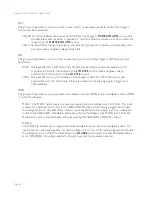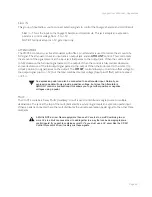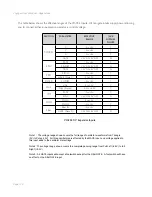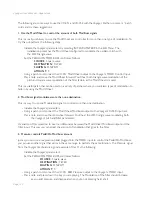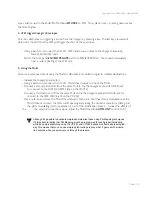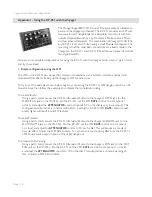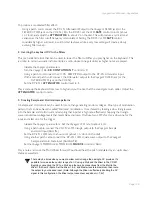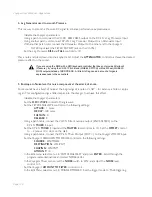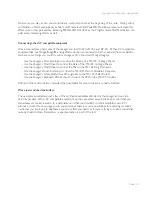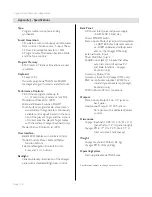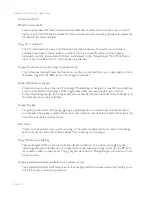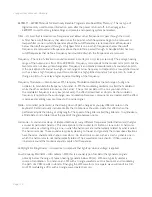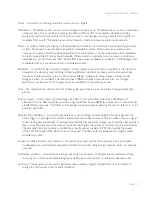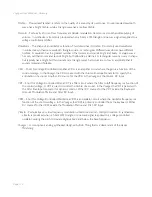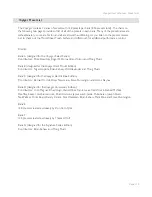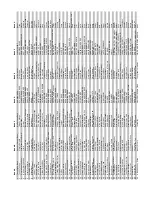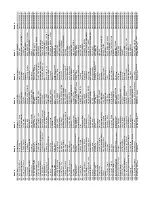
Page 112
Voyager User’s Manual - Glossary
Page 113
Voyager User’s Manual - Glossary
EEPROM – EEPROM stands for ‘Electrically Erasable Programmable Read Only Memory’. This is a type of
digital memory used to store information, even after the power is turned off. In the Voyager, the
EEPROM is used to store global settings and presets, and operating system parameters.
Filter – A circuit that removes some frequencies and allows other frequencies to pass through the circuit.
A filter has a cutoff frequency that determines the point at which frequencies begin to be removed. A
lowpass filter is one in which frequencies above the cutoff frequency are removed and all frequencies
below the cutoff are passed through. A highpass filter is one in which frequencies below the cutoff
frequency are removed and frequencies above the cutoff are passed through. A bandpass filter has two
cutoff frequencies that define a frequency band, outside of which the frequencies are removed.
Frequency – The rate of vibration in sound measured in Hertz (Hz or cycles per second). The average hearing
range of the human ear is from 20 to 20,000 Hz. Frequency corresponds to the musical term ‘pitch’, but the
two terms are not always interchangeable. Frequency is an objective measurement of a sound, while pitch
is the perception of a sound, low, high, or mid-ranged. A low frequency corresponds to a low-pitched sound
such as a bass; a high frequency sound corresponds to a high-pitched sound such as a piccolo. In music, a
change in pitch of one octave higher equals a doubling of the frequency.
Frequency Modulation – Also known as FM, Frequency Modulation describes the technique of using one
oscillator to modulate the frequency of another. In FM, the modulating oscillator is called the ‘modulator’,
while the other oscillator is known as the ‘carrier’. The carrier oscillator is the one you hear. When
the modulator frequency is very low (about 6Hz), the effect is described as vibrato. As the modulator
frequency is raised into the audio range, new modulation frequency components are created, and the effect
is perceived as adding new overtones to the carrier signal.
Glide – Also called portamento, is the slowing down of pitch changes as you play different notes on the
keyboard. Certain acoustic instruments, like the trombone or the violin, create this effect when the
performer adjusts the tubing or string length. The speed of the glide is called the glide rate. In synthesizers,
a Glide Rate control determines the speed of the glide between notes.
Harmonic – A sound is made up of simple vibrations at many different frequencies (called harmonics) that give
a sound its particular character. This corresponds to the musical term timbre or tone color. A harmonic
sound, such as a vibrating string, is one in which the harmonics are mathematically related by what is called
the harmonic series. These sounds are typically pleasing to the ear and generally the consecutive vibrations
have the same characteristic shape or waveform. An inharmonic sound, such as a crash cymbal, is one in
which the harmonics are not mathematically related. Their waveforms look chaotic. White noise is an
inharmonic sound that contains equal amounts of all frequencies.
LED (Light Emitting Diode) – An electrical component that lights up when a voltage is applied.
Low Frequency Oscillator – Also called an LFO, this is a special type of oscillator that generates signals
primarily below the range of human hearing (generally below 20 Hz). LFOs are typically used as a
source of modulation. For instance, an LFO with a triangle waveform, set to about 6 Hz and modulating
the pitch of a VCO results in vibrato. Changing the LFO waveform to a square wave will result in a trill.
An LFO modulating a VCA with a triangle wave creates tremolo.

